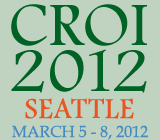 A modified version of the Viread (tenofovir) microbicide for rectal use has been found to be safe by researchers and acceptable by study volunteers who used the gel for seven days, according to new data from the Microbicide Trials Network (MTN) reported Tuesday, March 6, at the 19th Conference on Retroviruses and Opportunistic Infections (CROI) in Seattle.
A modified version of the Viread (tenofovir) microbicide for rectal use has been found to be safe by researchers and acceptable by study volunteers who used the gel for seven days, according to new data from the Microbicide Trials Network (MTN) reported Tuesday, March 6, at the 19th Conference on Retroviruses and Opportunistic Infections (CROI) in Seattle.
The rectal formulation, containing less glycerin than is found in the gel being explored in vaginal microbicide studies, will be advanced into a Phase II study further exploring its effectiveness and safety in both men and women, according to the researchers.
In light of data from a clinical trial suggesting that a tenofovir-based gel may reduce the risk of vaginal HIV transmission, there has been a great deal of interest in exploring the safety and benefits of the microbicide for rectal use.
In both the developed and developing world, receptive anal intercourse is practiced not only by men who have sex with men but also by women. The risk of acquiring HIV through unprotected anal sex is at least 20 times greater than with unprotected vaginal sex, and the risk increases if other infections are already present in the rectal lining.
Before large-scale rectal studies can be conducted—similar to vaginal microbicide trials currently under way—scientists first need to confirm they are using a gel that doesn’t damage rectal tissue and, as a result, potentially increase the risk of side effects as well as HIV transmission.
In one early trial (RMP-02/MTN-006), reported at last year’s CROI in Boston, the gel originally developed for vaginal use was associated with higher-than-expected rates of gastrointestinal problems when applied rectally. The researchers believed that the high concentration of glycerin in the gel was leading to significant alterations in the delicate balance of chemicals inside and outside of the rectal cells, causing those cells to expel water and potentially become damaged. In turn, a reduced glycerin version of the gel was developed.
The safety of the reduced glycerin formulation was explored in MTN-007 and reported at this year’s CROI by Ian McGowan, MD, of the University of Pittsburgh School of Medicine and his MTN colleagues. The study enrolled 65 HIV-negative volunteers who had engaged in receptive anal intercourse at least once in the previous year and who agreed to be sexually abstinent during the four- to eight-week period they are in the study. The average age was 36 years; 31 percent of the volunteers were female; and most (68 percent) were white.
Study volunteers were randomized into one of four groups. One group didn’t use any gel. A second group received an inactive (placebo) gel. A third group received the tenofovir gel. In the fourth group, study volunteers received an over-the-counter spermicide containing 2 percent nonoxynol-9.
Why nonoxynol-9, a compound that has already been studied as a microbicide and shown to damage the lining of the vagina, cause irritation and inflammation, and potentially increase the risk of HIV transmission? According to McGowan, it was included in MTN-007 for comparison purposes, to ensure the tenofovir gel didn’t cause similar side effects.
McGowan’s group reported that there weren’t any significant differences in side effects among the three gel groups, though rates of mild-to-moderate complaints appeared higher among those using nonoxynol-9 compared with the reduced-glycerin tenofovir gel.
The researchers also noted lower rates of specific side effects among those receiving the modified tenofovir gel in MTN-007, compared with those receiving the original formulation in RMP-02/MTN-006. According to McGowan, there were fewer reports of abdominal pain, urgent defecation, bloating, nausea and diarrhea in MTN-007.
Also reviewed by McGowan was a complex series of tests conducted at various time points to look for changes in the rectal mucosa that might signal safety concerns. Generally speaking, most documented changes were seen in rectal samples collected from study volunteers who used nonoxynol-9. The researchers did, however, find that the tenofovir gel was associated with changes in gene expression—notably a “turning off” of numerous genes in rectal mucosa—the clinical consequences of which being unknown.
Futher exploration of the tenofovir’s gel on gene expression is necessary, McGowan said.
Participants’ adherence to the use of their assigned study products was high, with 94 percent using the products daily as directed.
When asked about the likelihood that they would use the gel in the future, 87 percent of the participants who used the rectal formulation of tenofovir gel indicated they would likely use the gel again, compared with 93 percent of the placebo gel group, and 63 percent of the nonoxynol-9 gel group.
As a follow-up to MTN-007, the federally funded MTN plans to conduct MTN-017, a Phase II clinical trial that will enroll nearly 200 men who have sex with men and transgender women in South Africa, Peru, Thailand and the United States. Three regimens will be explored in the trial: Daily use of the rectal tenofovir gel, as-needed use of the gel (inserted before and after anal intercourse) and Truvada (tenofovir plus emtricitabine) taken orally every day.
MTN-017 is slated to begin this summer.
Advertisement
Advertisement
Advertisement






1 Comment
1 Comment